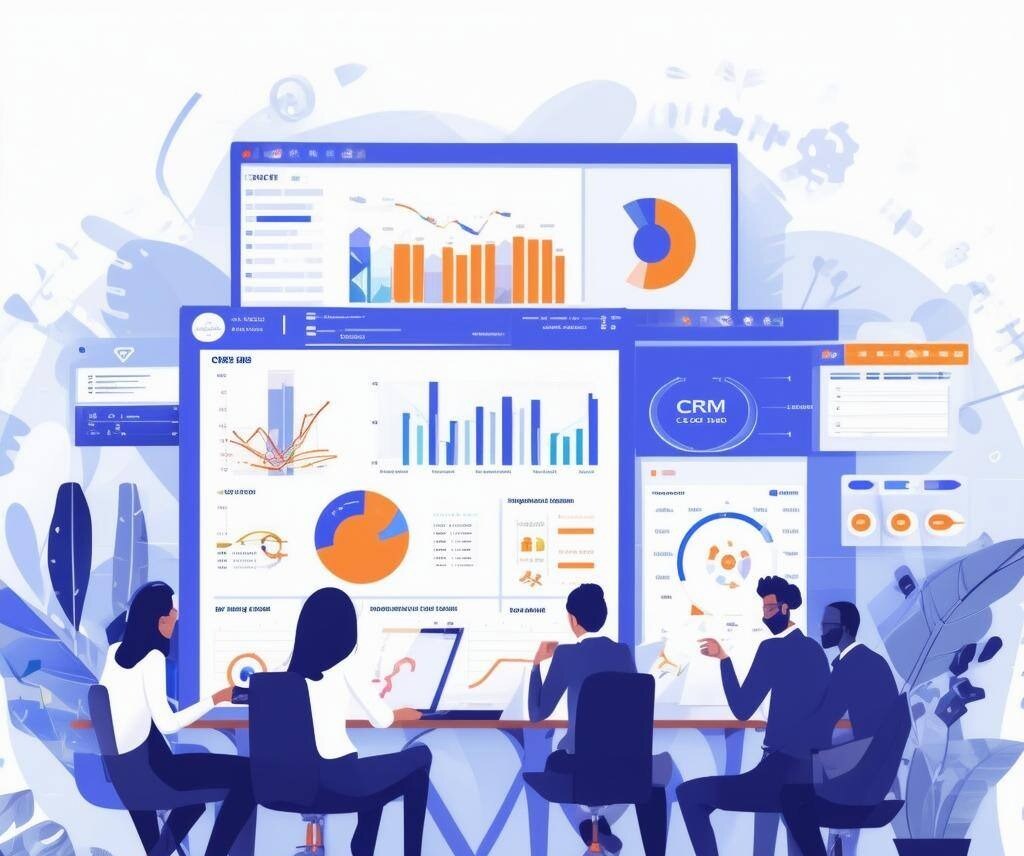The marketing landscape has undergone a significant transformation in recent years. Once defined by a relatively straightforward, linear progression of stages known as the marketing funnel, the path from prospect to loyal customer has become increasingly complex. Especially in the B2B space.
This evolution has revealed the limitations of traditional models and paved the way for more integrated and customer-centric approaches, namely full-funnel marketing and Revenue Operations (RevOps).
This article explores this paradigm shift, examining the definitions, characteristics, drivers, benefits, and future of these modern marketing strategies.
Deconstructing the Traditional Marketing Funnel: Understanding the Foundational Stages
The traditional marketing funnel is often conceptualized as a linear model that outlines the journey a potential customer takes from their initial awareness of a product or service to the final purchase (aka a funnel). Its primary aim is to attract a large audience at the initial stage and systematically guide them through distinct phases until they become paying customers. While variations exist, a common depiction includes stages such as awareness, interest or consideration, desire or decision, and action or conversion. Some models also extend beyond the purchase to include loyalty and even advocacy stages.
Awareness
The awareness stage marks the point at which a potential customer first becomes conscious of a problem they have or a need they possess, and they start looking for possible solutions. The primary goal for businesses at this stage is to build brand familiarity and ensure their name, messaging, and values resonate with the target audience, ultimately staying top-of-mind. This involves attracting customers through broad marketing efforts, utilizing channels like television, digital advertising, social media campaigns, and content marketing.
Interest
Once awareness is established, prospects enter the interest or consideration stage, where they begin to show interest in a group of services or products that could potentially address their needs. During this phase, they actively research potential solutions, seeking to learn more about the company, its brand, and the specifics of its offerings. The objective here is to educate and inform these potential customers, building trust and highlighting what differentiates the brand from its competitors. Tactics employed at this stage might include ensuring a user-friendly website experience, providing helpful content such as eBooks and whitepapers, sharing case studies, and hosting webinars.
Decision
As prospects move further down the funnel, they reach the desire, decision, or conversion stage. Here, they begin to evaluate a specific brand more closely. They assess the strength of the offer, compare it to their budget, and consider the expected outcomes of using the product or service. The goal for businesses is to encourage a purchase by clearly demonstrating their unique value proposition and how they stand out from the competition. Strategies at this point often involve well-detailed product pages, exceptional customer service, sharing testimonials, and potentially offering discounts or creating a sense of urgency.
Action
The action or purchase stage is the culmination of these efforts, where the prospect finally decides whether to make a purchase. The focus here is on making the buying process as seamless and straightforward as possible.
Post-Funnel
Beyond the initial purchase, the traditional funnel can also include a loyalty stage, which concentrates on turning first-time buyers into repeat customers. This typically involves marketing tactics designed to foster ongoing relationships, such as loyalty programs and exclusive offers.
The Evolution
While the traditional marketing funnel has served as a foundational framework for many years, its limitations in reflecting the complexities of modern customer behavior have become increasingly apparent. The linear nature of the model doesn't always align with how customers actually make purchasing decisions. Individuals may not always enter at the top of the funnel and progress neatly through each stage. Instead, the buying journey is often non-linear, with customers potentially jumping directly to the middle or bottom of the funnel if they are already aware of their problem and potential solutions. Furthermore, the traditional funnel often places a significant emphasis on acquiring new customers, sometimes at the expense of focusing on retaining and nurturing existing ones.
The evolution of the traditional funnel model itself, from the initial AIDA framework to the inclusion of TOFU-MOFU-BOFU and the subsequent addition of loyalty and advocacy stages, illustrates a growing understanding of the multifaceted nature of the customer journey and the increasing importance of engaging with customers beyond the initial transaction. This recognition of the need for sustained engagement signals a move towards a more comprehensive view of marketing.
The Paradigm Shift: A Holistic Approach to the Customer Journey
In response to the limitations of the traditional funnel, full-funnel marketing has emerged as a more holistic strategy. Full-funnel marketing targets potential customers at every stage of their journey, from the initial awareness phase all the way through to the decision point and even beyond. It involves crafting a cohesive and integrated strategy that spans across all relevant marketing channels and customer touchpoints. Unlike the traditional funnel's often singular focus on driving immediate sales, full-funnel marketing emphasizes nurturing relationships and building positive brand experiences throughout the entire customer lifecycle 13.
Contrasting with the traditional funnel's linear progression, full-funnel marketing acknowledges the reality that customers can enter the buying process at any stage, and their journey is often characterized by interactions across multiple channels and a potentially rapid progression through stages. Full-funnel marketing strategies are often structured around three primary stages: Top of Funnel (TOFU), Middle of Funnel (MOFU), and Bottom of Funnel (BOFU), with a growing recognition of the crucial post-funnel phase.
At the TOFU stage, the primary focus is on building brand awareness and reaching a broad audience of potential customers. The goal is to attract attention and introduce people to the brand through engaging and educational content that addresses their needs, rather than immediately trying to convert them into customers . The MOFU stage centers on nurturing leads who have shown some initial interest. The focus shifts to providing valuable information, building trust, and positioning the brand as a viable solution to their problems. Finally, the BOFU stage is where the focus sharpens on driving conversions. The objective is to persuade qualified leads to make a purchase through targeted messaging and compelling offers, making the path to purchase as easy as possible. Increasingly, marketing efforts extend to the post-funnel stage, which emphasizes customer retention, fostering loyalty, and encouraging customers to become brand advocates through continued engagement and support.
Adopting a full-funnel strategy offers numerous benefits for businesses. It leads to increased brand awareness by ensuring the brand stays top-of-mind through consistent messaging. It fosters stronger audience engagement by delivering relevant content at every touchpoint.
Full-funnel marketing also improves lead nurturing by providing valuable information and timely follow-ups, guiding prospects through the decision-making process more effectively. This comprehensive approach ultimately results in higher conversion rates and better overall marketing efficiency. Furthermore, a full-funnel strategy helps businesses reach new audiences, increase consideration for their offerings, drive more sales over the long term, and cultivate lasting customer loyalty. This signifies a fundamental shift in perspective, moving from a purely transactional view of customer interactions to a more relational approach that prioritizes long-term engagement and value creation at every stage of the customer's journey.
Introducing Revenue Operations (RevOps): Aligning Teams for Revenue Growth
Complementing the full-funnel marketing approach is the concept of Revenue Operations (RevOps). RevOps represents a strategic business function that integrates and aligns sales, marketing, and customer success operations across the entire customer lifecycle to drive growth through operational efficiency and keep all teams accountable to revenue. At its core, RevOps is about breaking down the traditional silos that often exist between these departments and creating a unified, data-driven approach to optimizing the entire revenue generation process.
The core principles underpinning RevOps include ensuring alignment across departments towards common revenue goals, maintaining a customer-centric focus throughout all operations, leveraging data-driven decision-making to inform strategies and actions, and striving for operational efficiency by streamlining processes and eliminating redundancies.
Implementing a RevOps approach is driven by several key goals. Primarily, it aims to drive revenue growth by optimizing the entire customer journey. It also seeks to improve efficiency by standardizing processes and automating tasks. Enhancing the customer experience through a more unified and consistent approach is another crucial objective. RevOps also aims to increase predictability in revenue generation and provide better data insights across all revenue-related activities.
The key functions of a RevOps team in modern organizations are multifaceted. They typically include managing the technology stack used by sales, marketing, and customer success teams, ensuring these tools are integrated and effective. Implementing data-driven processes and analytics is another critical function, using data to identify trends, optimize strategies, and improve performance.
RevOps also plays a vital role in coordinating efforts across multiple teams, breaking down silos and fostering collaboration. Ensuring a seamless revenue cycle from lead generation to customer retention is a central focus. RevOps is responsible for optimizing processes to eliminate bottlenecks and improve efficiency. Finally, providing enablement and insights to revenue-generating teams, equipping them with the necessary resources and knowledge to succeed, is a key aspect of the RevOps function.
One of the primary advantages of implementing RevOps is its ability to foster alignment between marketing, sales, and customer success teams. This alignment leads to improved collaboration and communication, ensuring that all teams are working towards the same goals and providing a more unified and consistent customer journey.
RevOps represents a strategic evolution that extends beyond simply aligning sales and marketing efforts. It encompasses the entire revenue-generating process, with a strong emphasis on optimizing the customer journey to maximize customer lifetime value.
The Forces Behind the Transformation: Why Traditional Models Are Evolving
The increasing adoption of full-funnel marketing and RevOps is driven by several key factors. A significant driver is the fundamental shift in customer behavior in the digital age. Today's customers are more informed than ever before, with vast amounts of information readily available at their fingertips. They have a multitude of choices and their purchasing journey is no longer a straightforward, linear path. Instead, they engage with brands across multiple channels and expect personalized and consistent experiences throughout their interactions.
The traditional, top-down marketing funnel, which often treated customers as passively moving through distinct stages, struggles to effectively address this more dynamic and empowered customer.
Additionally, technological advancements have played a crucial role in enabling and necessitating these shifts. The widespread availability of the internet and broadband access has empowered customers with unprecedented access to information. The proliferation of mobile devices and social media has fragmented the customer journey, requiring businesses to engage with customers across a multitude of touchpoints. Marketing automation platforms and CRM systems have provided businesses with the tools to nurture leads, personalize communications, and manage customer relationships at scale.
Data analytics capabilities have also advanced significantly, allowing businesses to gain deeper insights into customer behavior and optimize their marketing efforts accordingly. This technological landscape has fundamentally changed how customers interact with brands and how businesses can effectively reach and engage with them. The power has shifted, to a large extent, from businesses controlling the flow of information to customers actively seeking it out and shaping their own buying journeys.
Full-funnel marketing and RevOps are designed to address this new reality by focusing on understanding and meeting the customer's needs throughout their increasingly complex and non-linear journey.
Benefits Realized: The Advantages of Integrated Strategies
The adoption of full-funnel marketing brings a wealth of advantages to businesses. By deeply understanding their customers' journeys, companies can create tailored content that meets specific needs at each stage, leading to more effective engagement. This approach also boosts brand awareness, fostering trust and leading to faster conversions and increased customer loyalty.
A content-rich full-funnel strategy drives organic traffic to websites, strengthening SEO and reducing reliance on paid advertising. By focusing on long-term customer relationships, businesses experience increased ROI and can leverage customer data for personalized marketing campaigns. Nurturing relationships through consistent communication and valuable content further enhances customer engagement. The full-funnel approach also allows for easy performance measurement at each stage, enabling continuous optimization of marketing efforts. Furthermore, it keeps the audience pipeline fresh by continuously introducing the brand to new potential customers, and nurturing those leads through the middle of the funnel can lower the cost per action over time.
For higher-consideration products, it builds crucial trust and brand recognition. Running a mix of campaign types across the funnel strengthens platform algorithms, ultimately improving the performance of conversion campaigns and future-proofing the overall marketing strategy.
Implementing a RevOps framework also yields significant benefits. Businesses can expect more predictable business growth through accurate and consistent measurements. RevOps facilitates better management of resources by streamlining processes and identifying inefficiencies. Increased transparency across sales, marketing, and customer success teams leads to better alignment and collaboration.
A unified approach results in a better customer experience with more consistent and personalized interactions. Enhanced efficiency is achieved by eliminating operational redundancies and streamlining workflows. RevOps enables clearer decision-making by providing a centralized view of data and performance metrics. It fosters improved collaboration between traditionally siloed teams, leading to more cohesive strategies.
This alignment can also lead to higher employee engagement and retention as teams work towards shared goals. Ultimately, RevOps contributes to increased revenue growth and profitability through optimized processes and a focus on the entire customer lifecycle, while also leading to lower customer churn rates due to improved customer satisfaction.
|
Feature |
Traditional Marketing Funnel |
Full-Funnel Marketing |
Revenue Operations (RevOps) |
|
Focus |
Linear progression from awareness to purchase |
Engaging customers at every stage of their journey and beyond |
Aligning people, processes, and technology across revenue-generating teams |
|
Customer Journey |
Primarily linear |
Non-linear, multichannel |
Focuses on optimizing the entire customer lifecycle |
|
Team Alignment |
Often siloed departments |
Emphasizes consistent experience across all touchpoints |
Integrates and aligns sales, marketing, and customer success teams |
|
Data Utilization |
Can be limited to specific stages |
Data-driven optimization at each stage |
Centralizes and leverages data for insights and decision-making across all revenue functions |
|
Primary Goal |
Drive conversions at the bottom of the funnel |
Nurture relationships and build brand experience |
Drive revenue growth, improve efficiency, and enhance customer experience |
|
Key Benefits |
Basic understanding of customer journey, measurable stages |
Increased brand awareness, stronger engagement, higher conversions, better loyalty |
Improved collaboration, enhanced efficiency, better data insights, predictable growth |
Success in Action: Case Studies and Examples
Numerous companies have successfully implemented full-funnel marketing strategies to achieve significant results. Netflix, for example, leverages a simple yet effective four-stage funnel, starting with striking branding and a user-friendly website, followed by ad retargeting to recapture interest, a clear call-to-action for a free trial, and an automatic conversion to a paid subscription. Their content personalization powered by machine learning further enhances customer retention.
Grammarly employs a multi-level channel approach, strategically placing advertisements across various platforms to influence prospects at different stages of their buying journey.
Alkami has demonstrated the power of full-funnel marketing for financial institutions, using personalized, multi-channel campaigns to drive significant growth in deposit accounts. One campaign resulted in 245 new CDs opened over ten months, showcasing the effectiveness of reaching account holders through digital and mobile banking channels, as well as the institution's website. Another campaign yielded 27 new money market accounts in just one month by targeting individuals with personalized ads through their digital banking app.
The adoption of RevOps has also led to notable success stories across various industries. Thermo Fisher Scientific, a healthcare contract manufacturer, improved global collaboration and reduced operational costs by 12% after implementing RevOps, which included centralizing their CRM system and automating sales processes.
Siemens, a global manufacturing firm, saw a 15% decrease in customer acquisition costs and increased customer retention rates by aligning their sales and marketing efforts through RevOps, integrating their CRM with marketing automation tools and leveraging data analytics.
HubSpot (a favorite of ours), a SaaS company, enhanced operational efficiency and achieved scalable growth by centralizing customer data into a single CRM platform and automating lead scoring and routing, resulting in a 20% increase in lead conversion rates. -- They're also leading the charge in the PaaS space.
Salesforce has a dedicated RevOps team focused on improving the customer journey and driving revenue growth by breaking down silos.
These examples underscore the tangible benefits of both full-funnel marketing and RevOps in driving positive business outcomes, including increased revenue, improved efficiency, enhanced customer satisfaction, and stronger customer relationships.
Looking Ahead: The Future of Integrated Marketing
At Tough Terrain Media, we believe full-funnel strategies and RevOps will only become more critical in the future of marketing. Emerging trends and technologies are set to further shape this landscape. Artificial intelligence (AI) and predictive analytics are expected to power even greater levels of personalization across the entire customer journey. The rise of interactive and shoppable content will create more engaging experiences and streamline the path to purchase.
With increasing concerns around data privacy, businesses will need to prioritize first-party data collection and build trust with their customers. The integration of virtual and augmented reality will offer new and immersive ways for brands to connect with their audiences. Furthermore, customer retention and loyalty will become even more central to marketing strategies.
We can't over emphasize the growing importance of RevOps for achieving business goals and optimizing the customer lifecycle. A significant majority of high-growth companies have already adopted a RevOps model, highlighting its perceived value in driving efficiency and revenue. The integration of generative AI into RevOps strategies is anticipated to provide deeper insights through predictive analytics and automate workflows, leading to enhanced customer experiences.
Organizational structures are also expected to evolve to further emphasize collaboration and alignment across departments, with RevOps playing a central role in fostering these cross-functional teams. RevOps will be the crucial function that manages and optimizes these complex, technology-driven marketing ecosystems.
Conclusion: Embracing the Blurring Lines for Marketing Success
The journey of marketing has moved far beyond the simple, linear path of the traditional funnel. The modern customer journey is dynamic, multi-faceted, and demands a more integrated and customer-centric approach. Full-funnel marketing provides the overarching framework for engaging customers at every stage, while Revenue Operations offers the strategic alignment and operational efficiency needed to optimize the entire revenue engine. The benefits of these integrated strategies are clear: deeper customer understanding, enhanced engagement, improved efficiency, and ultimately, stronger revenue growth.
As the lines between marketing stages and between traditionally separate teams continue to blur, embracing these modern approaches will be essential for businesses looking to achieve sustained success in the modern marketing landscape.
The team here at Tough Terrain Media are well-positioned to guide businesses through this transformation, helping them navigate the complexities of full-funnel marketing and implement effective RevOps strategies to achieve their marketing and revenue goals.
The blurring of lines is not a challenge to be feared, but rather an opportunity to create more effective, customer-focused, and ultimately, more successful marketing outcomes.





